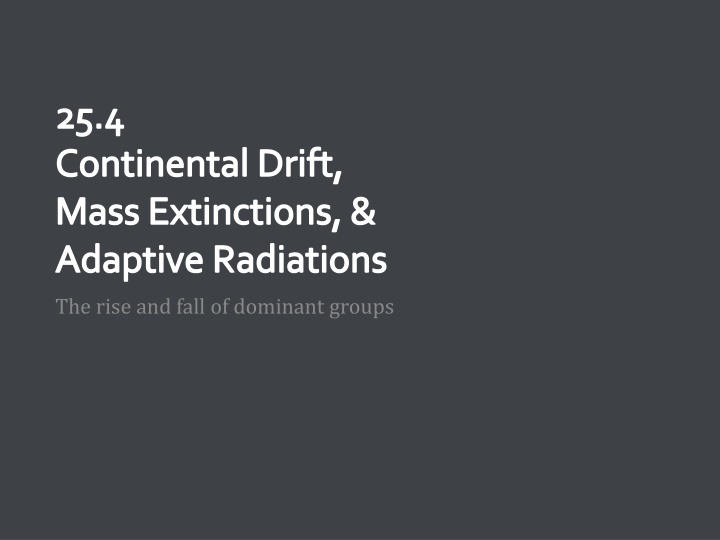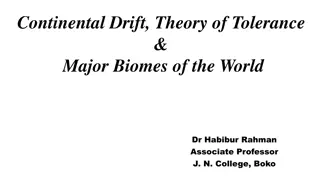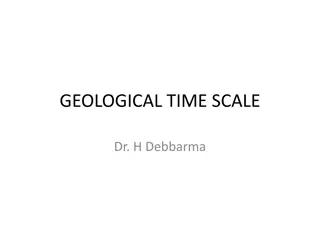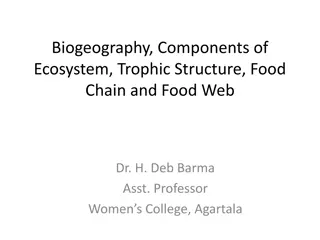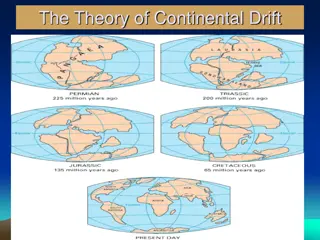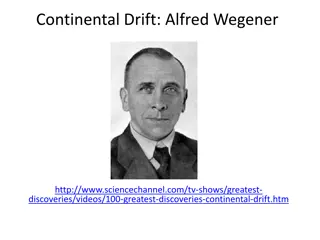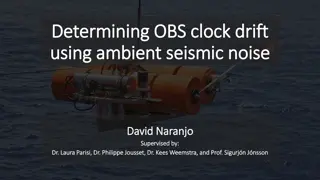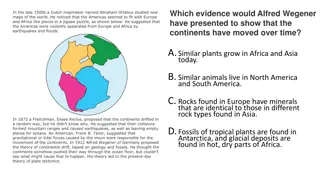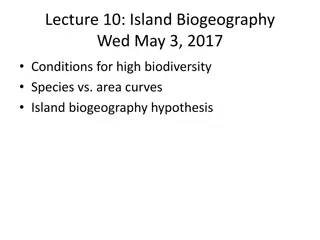The Impact of Continental Drift on Earth's Biogeography
Continental drift, caused by the movement of tectonic plates, has had profound effects on Earth's habitats and the distribution of organisms. From the formation of supercontinents to the separation of land masses, these geological processes have led to climate change, speciation events, mass extinctions, and the unique distribution of living and extinct organisms across the planet.
Download Presentation

Please find below an Image/Link to download the presentation.
The content on the website is provided AS IS for your information and personal use only. It may not be sold, licensed, or shared on other websites without obtaining consent from the author.If you encounter any issues during the download, it is possible that the publisher has removed the file from their server.
You are allowed to download the files provided on this website for personal or commercial use, subject to the condition that they are used lawfully. All files are the property of their respective owners.
The content on the website is provided AS IS for your information and personal use only. It may not be sold, licensed, or shared on other websites without obtaining consent from the author.
E N D
Presentation Transcript
25.4 Continental Drift, Mass Extinctions, & Adaptive Radiations The rise and fall of dominant groups
Continental Drift The continents are part of great plates of the Earth s crust that essentially float on the underlying portion of the mantle When these plates move it is called Continental Drift Geologists are able to measure the rate at which the plates move today, usually only a few centimeters per year
Continental Drift (cont.) Many important geological processes, formation of mountains and islands, occur at plate boundaries. Some cases two plates move away from each other Ex. North America and Eurasian plates, currently moving apart at a rate of about 2 cm per year Some cases two plates slide past each other and this is where earthquakes are common Ex. San Andreas Fault Some cases two plates colide Ex. Himalayan mountains when the Indian plate crashed into the Eurasian plate
Consequences of Continental Drift Although plate movement is slow, the overall effects are dramatic Effects of Continental drift: Alters the habitats in which organisms live It s said that millions of years ago the plate moved separated land masses together to form a supercontinent, Pangea. The Pangea destroyed the habitat of the animals. Driving some animals to extinction
Consequences cont. Effects of Continental drift: Climate change that results when a continent shifts northward or southward Ex. Southern tip of Labrador, Canada. It was once located near the equator but has moved 40 degrees north. This causes organisms to adapt, move, or become extinct. Some believe that the shifting positions of the continents have rerouted the ocean currents causing the global climate to be colder & contributes to the formation of ice caps. Promotes allopatric speciation on a grand scale When supercontinents break apart, regions that were connected now become geographically isolated. As the continents have drifted apart, each continent began to get their own lineages of plants and animals.
Consequences cont. Effects of Continental drift: It can help explain puzzles about geographic distribution of extinct organisms It also helps explain the distribution of living organisms. Marsupials used to exist in multiple places orginating most likely in Asia and North America. Continental drift carried marsupials on Australia where they diversified while marsupials became extinct on other continents.
Mass Extinctions Mass Extinction- abnormally large numbers of species become extinct throughout Earth. A majority of species that have existed are now extinct. This is shown by the fossil record. Reasons for extinction could be: Destruction of habitat An unfavorable change to the environment
Mass Extinctions cont. The Big Five Mass Extinctions In each mass extinction 50% of Earth s marine species became extinct. The Big Five Ordovician Late Devonian Permian* Triassic-Jurassic Cretaceous*
Mass Extinction cont. Permian extinction Modern day Serbia Enormous Volcanic Eruptions Most extreme episode of volcanism in the past half billion years Reduced temperature differences between the poles and the equator slowed mixing of ocean water. This reduced the amount of oxygen available to marine organisms.
Mass Extinction cont. Cretaceous extinction Took out more than 1/2 of all marine species, and many land plants and animals (including most dinosaurs) Possible cause: iridium which is an element that is very rare on Earth but common in meteorites and other extraterrestrial objects A cloud of debris came into the atmosphere when an asteroid or a large comet collided with Earth. The cloud would have also blocked sunlight changing the climate for many months. Chicxulubcrater: off the coast of Mexico; 10 km wide (over 6 miles wide)
Results of Mass Extinctions Completely changes an ecological community Organisms found in the ecosystems will change When an evolutionary lineage disappears, it cannot reappear which changes the course of evolution It takes about 5-10 million years for the diversity of life to recover from a mass extinction. Paves the way for adaptive radiation.
Adaptive Radiation Periods of evolutionary change in which groups of organisms form many new species whose adaptations allow them to fill different ecological roles, or niches, in their communities Adaptive radiations occur when a few organisms make their way into new areas, when novel adaptations arise, or when extinction opens up ecological niches for surviving species. Large-scale adaptive radiations followed each of the five mass extinctions Adaptive radiations occurred in groups of organisms that possessed major evolutionary innovations, such as armored body coverings. Organisms colonizing regions with little competition from other species have undergone major adaptive radiations.
Adaptive Radiation cont. In some adaptive radiations, groups of organisms increased in diversity as they came to play entirely new ecological roles in their communities Examples include the rise of photosynthetic prokaryotes; the evolution of predatory animals during the Cambrian explosion; and the plants, insects, and tetrapod radiations that followed the colonization of land Each of these radiations was associated with major evolutionary innovations that facilitated life on land Also organisms that arise in an adaptive radiation may serve as a new source of food for still other organisms
World-Wide Adaptive Radiations Ancestral mammal Monotremes (5 species) ANCESTRAL CYNODONT Marsupials (324 species) Eutherians (placental mammals; 5,010 species) 250 100 150 0 50 200 Millions of years ago Mammals underwent a dramatic adaptive radiation following the extinction of the dinosaurs 65 million years ago. Before they were restricted to smaller sizes as a result of competition from the larger dinosaurs, but with the disappearance of the dinosaurs, mammals diversified to fill the ecological roles once occupied by dinosaurs.
Regional Adaptive Radiation Adaptive radiation can also occur over a more limited geographic area Such radiations can be initiated when a few organisms make their way to a new, often distant location with limited competition from other organisms The Hawaiian archipelagos showcases this type of radiation because each island was born naked with immense physical diversity and was gradually populated by stray organisms from the wind or ocean Multiple invasions, followed by speciation events, have ignited an explosion of adaptive radiations of novel species with many of the thousands of species there found nowhere else on Earth
Hawaiian Islands Regional Adaptive Radiations Close North American relative, the tarweed Carlquistia muirii MOLOKA I MOLOKAIMAUI Close North American relative, the tarweed Carlquistia muirii 1.3 KAUAI 5.1 million years 5.1 million years Dubautia laxa Dubautia laxa million years 1.3 million years MAU I KAUAI OAHU 3.7 million years 3.7 million years Argyroxiphium sandwicense Argyroxiphiumsandwicense LANA I LANAI OAHU HAWAII 0.4 million years 0.4 million years HAWAII Dubautia waialealae Dubautia waialealae Dubautia scabra Dubautia linearis Dubautia scabra Dubautia linearis
